本文記錄個人使用MySQL插入大數(shù)據(jù)總結(jié)較實(shí)用的方案,通過對常用插入大數(shù)據(jù)的4種方式進(jìn)行測試,即for循環(huán)單條、拼接SQL、批量插入saveBatch()、循環(huán) + 開啟批處理模式,得出比較實(shí)用的方案心得。
一、前言
最近趁空閑之余,在對MySQL數(shù)據(jù)庫進(jìn)行插入數(shù)據(jù)測試,對于如何快速插入數(shù)據(jù)的操作無從下手,在僅1W數(shù)據(jù)量的情況下,竟花費(fèi)接近47s,實(shí)在不忍直視!在不斷摸索之后,整理出一些較實(shí)用的方案。
二、準(zhǔn)備工作
測試環(huán)境:SpringBoot項(xiàng)目、MyBatis-Plus框架、MySQL8.0.24、JDK13
前提:SpringBoot項(xiàng)目集成MyBatis-Plus上述文章有配置過程,同時實(shí)現(xiàn)IService接口用于進(jìn)行批量插入數(shù)據(jù)操作saveBatch()方法
1、Maven項(xiàng)目中pom.xml文件引入的相關(guān)依賴如下
org.springframework.boot spring-boot-starter-web com.baomidou mybatis-plus-boot-starter 3.3.1 mysql mysql-connector-java org.projectlombok lombok
2、application.yml配置屬性文件內(nèi)容(重點(diǎn):開啟批處理模式)
server: #端口號 port:8080 #MySQL連接配置信息(以下僅簡單配置,更多設(shè)置可自行查看) spring: datasource: #連接地址(解決UTF-8中文亂碼問題+時區(qū)校正) #(rewriteBatchedStatements=true開啟批處理模式) url:jdbc//127.0.0.1:3306/bjpowernode?useUnicode=true&characterEncoding=UTF-8&serverTimezone=Asia/Shanghai&rewriteBatchedStatements=true #用戶名 username:root #密碼 password:xxx #連接驅(qū)動名稱 driver-class-name:com.mysql.cj.jdbc.Driver
3、Entity實(shí)體類(測試)
/**
*Student測試實(shí)體類
*
*@Data注解:引入Lombok依賴,可省略Setter、Getter方法
*@authorLBF
*@date2022/3/1816:06
*/
@Data
@TableName(value="student")
publicclassStudent{
/**主鍵type:自增*/
@TableId(type=IdType.AUTO)
privateintid;
/**名字*/
privateStringname;
/**年齡*/
privateintage;
/**地址*/
privateStringaddr;
/**地址號@TableField:與表字段映射*/
@TableField(value="addr_num")
privateStringaddrNum;
publicStudent(Stringname,intage,Stringaddr,StringaddrNum){
this.name=name;
this.age=age;
this.addr=addr;
this.addrNum=addrNum;
}
}
4、數(shù)據(jù)庫student表結(jié)構(gòu)(注意:無索引)
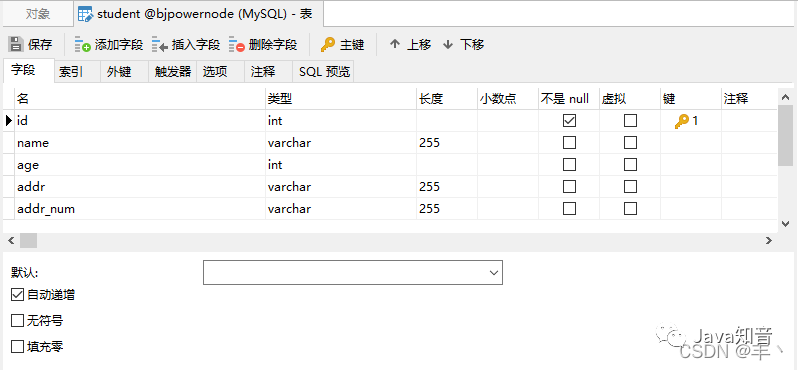
三、測試工作
簡明:完成準(zhǔn)備工作后,即對for循環(huán)、拼接SQL語句、批量插入saveBatch()、循環(huán)插入+開啟批處理模式,該4種插入數(shù)據(jù)的方式進(jìn)行測試性能。
注意:測試數(shù)據(jù)量為5W、單次測試完清空數(shù)據(jù)表(確保不受舊數(shù)據(jù)影響)
以下測試內(nèi)容可能受測試配置環(huán)境、測試規(guī)范和數(shù)據(jù)量等諸多因素影響,讀者可自行結(jié)合參考進(jìn)行測試
1、for循環(huán)插入(單條)(總耗時:177秒)
總結(jié):測試平均時間約是177秒,實(shí)在是不忍直視(捂臉),因?yàn)槔胒or循環(huán)進(jìn)行單條插入時,每次都是在獲取連接(Connection)、釋放連接和資源關(guān)閉等操作上,(如果數(shù)據(jù)量大的情況下)極其消耗資源,導(dǎo)致時間長。
@GetMapping("/for") publicvoidforSingle(){ //開始時間 longstartTime=System.currentTimeMillis(); for(inti=0;i
(1)第一次測試結(jié)果:190155 約等于 190秒
(2)第二次測試結(jié)果:175926 約等于 176秒(服務(wù)未重啟)
(3)第三次測試結(jié)果:174726 約等于 174秒(服務(wù)重啟)
2、拼接SQL語句(總耗時:2.9秒)
簡明:拼接格式:insert into student(xxxx) value(xxxx),(xxxx),(xxxxx).......
總結(jié):拼接結(jié)果就是將所有的數(shù)據(jù)集成在一條SQL語句的value值上,其由于提交到服務(wù)器上的insert語句少了,網(wǎng)絡(luò)負(fù)載少了,性能也就提上去。
但是當(dāng)數(shù)據(jù)量上去后,可能會出現(xiàn)內(nèi)存溢出、解析SQL語句耗時等情況,但與第一點(diǎn)相比,提高了極大的性能。
@GetMapping("/sql") publicvoidsql(){ ArrayListarrayList=newArrayList<>(); longstartTime=System.currentTimeMillis(); for(inti=0;i //使用@Insert注解插入:此處為簡便,不寫Mapper.xml文件 @Insert("") intinsertSplice(@Param("studentList")ListstudentList);
(1)第一次測試結(jié)果:3218 約等于 3.2秒
(2)第二次測試結(jié)果:2592 約等于 2.6秒(服務(wù)未重啟)
(3)第三次測試結(jié)果:3082 約等于 3.1秒(服務(wù)重啟)
3、批量插入saveBatch(總耗時:2.7秒)
簡明:使用MyBatis-Plus實(shí)現(xiàn)IService接口中批處理saveBatch()方法,對底層源碼進(jìn)行查看時,可發(fā)現(xiàn)其實(shí)是for循環(huán)插入,但是與第一點(diǎn)相比,為什么性能上提高了呢?因?yàn)槔梅制幚恚╞atchSize = 1000) + 分批提交事務(wù)的操作,從而提高性能,并非在Connection上消耗性能。
@GetMapping("/saveBatch1") publicvoidsaveBatch1(){ ArrayListarrayList=newArrayList<>(); longstartTime=System.currentTimeMillis(); //模擬數(shù)據(jù) for(inti=0;i
(1)第一次測試結(jié)果:2864 約等于 2.9秒
(2)第二次測試結(jié)果:2302 約等于 2.3秒(服務(wù)未重啟)
(3)第三次測試結(jié)果:2893 約等于 2.9秒(服務(wù)重啟)
重點(diǎn)注意:MySQL JDBC驅(qū)動默認(rèn)情況下忽略saveBatch()方法中的executeBatch()語句,將需要批量處理的一組SQL語句進(jìn)行拆散,執(zhí)行時一條一條給MySQL數(shù)據(jù)庫,造成實(shí)際上是分片插入,即與單條插入方式相比,有提高,但是性能未能得到實(shí)質(zhì)性的提高。
測試:數(shù)據(jù)庫連接URL地址缺少 rewriteBatchedStatements = true 參數(shù)情況
#MySQL連接配置信息 spring: datasource: #連接地址(未開啟批處理模式) url:jdbc//127.0.0.1:3306/bjpowernode?useUnicode=true&characterEncoding=UTF-8&serverTimezone=Asia/Shanghai #用戶名 username:root #密碼 password:xxx #連接驅(qū)動名稱 driver-class-name:com.mysql.cj.jdbc.Driver
測試結(jié)果:10541 約等于 10.5秒(未開啟批處理模式)
4、循環(huán)插入 + 開啟批處理模式(總耗時:1.7秒)(重點(diǎn):一次性提交)
簡明:開啟批處理,關(guān)閉自動提交事務(wù),共用同一個SqlSession之后,for循環(huán)單條插入的性能得到實(shí)質(zhì)性的提高;由于同一個SqlSession省去對資源相關(guān)操作的耗能、減少對事務(wù)處理的時間等,從而極大程度上提高執(zhí)行效率。(目前個人覺得最優(yōu)方案)
@GetMapping("/forSaveBatch") publicvoidforSaveBatch(){ //開啟批量處理模式BATCH、關(guān)閉自動提交事務(wù)false SqlSessionsqlSession=sqlSessionFactory.openSession(ExecutorType.BATCH,false); //反射獲取,獲取Mapper StudentMapperstudentMapper=sqlSession.getMapper(StudentMapper.class); longstartTime=System.currentTimeMillis(); for(inti=0;i
(1)第一次測試結(jié)果:1831 約等于 1.8秒
(2)第二次測試結(jié)果:1382 約等于 1.4秒(服務(wù)未重啟)
(3)第三次測試結(jié)果:1883 約等于 1.9秒(服務(wù)重啟)
四、總結(jié)
本文記錄個人學(xué)習(xí)MySQL插入大數(shù)據(jù)一些方案心得,可得知主要是在獲取連接、關(guān)閉連接、釋放資源和提交事務(wù)等方面較耗能,其中最需要注意是開啟批處理模式,即URL地址的參數(shù):rewriteBatchedStatements = true,否則也無法發(fā)揮作用。
對于測試方案的設(shè)定、對考慮不周、理解和編寫錯誤的地方等情況,請多指出,共同學(xué)習(xí)!
審核編輯:湯梓紅
-
數(shù)據(jù)庫
+關(guān)注
關(guān)注
7文章
3904瀏覽量
65824 -
spring
+關(guān)注
關(guān)注
0文章
340瀏覽量
14911 -
MySQL
+關(guān)注
關(guān)注
1文章
849瀏覽量
27611
原文標(biāo)題:MySQL批量插入數(shù)據(jù)的四種方案(性能測試對比)
文章出處:【微信號:AndroidPush,微信公眾號:Android編程精選】歡迎添加關(guān)注!文章轉(zhuǎn)載請注明出處。
發(fā)布評論請先 登錄
RDMA簡介3之四種子協(xié)議對比
labview插入數(shù)據(jù)MySQL數(shù)據(jù)庫
幾種數(shù)據(jù)庫的大數(shù)據(jù)批量插入解決方法
測試比較四種Arduino Nano全新型號的數(shù)據(jù)詳細(xì)說明
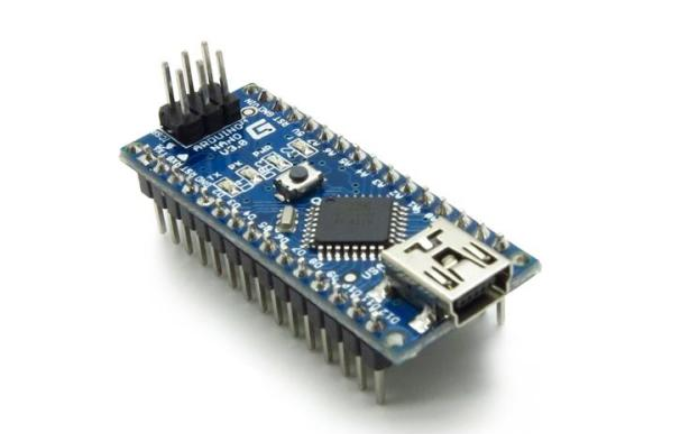
MySQL數(shù)據(jù)庫:如何操作禁止重復(fù)插入數(shù)據(jù)

MySQL 批量插入不重復(fù)數(shù)據(jù)的解決方法
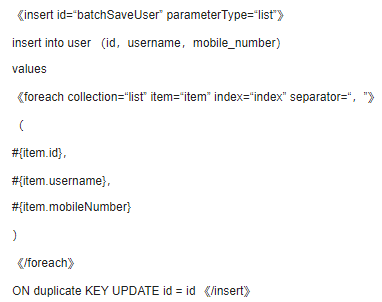
MyBatis批量插入數(shù)據(jù)的3種方法你知道幾種






 MySQL批量插入數(shù)據(jù)的四種方案(性能測試對比)
MySQL批量插入數(shù)據(jù)的四種方案(性能測試對比)













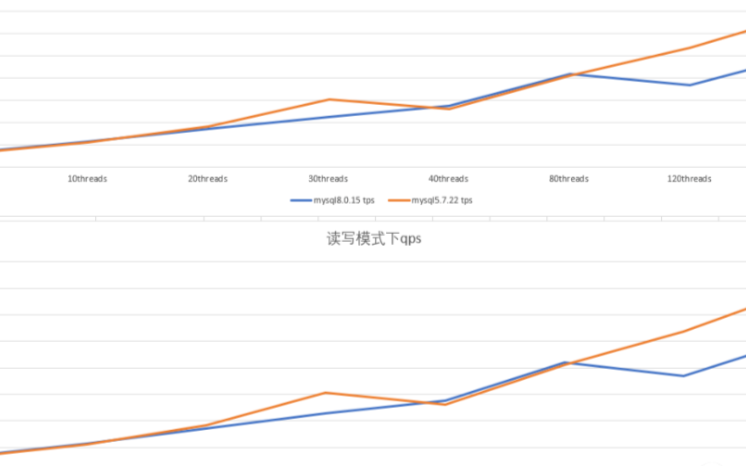
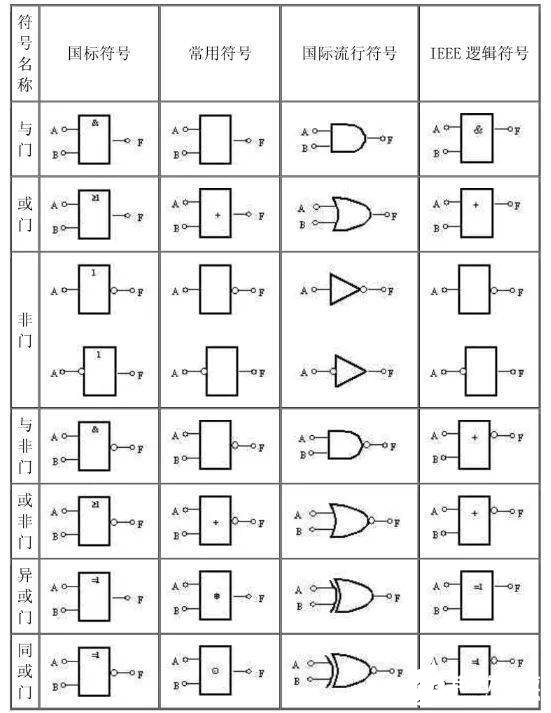










評論